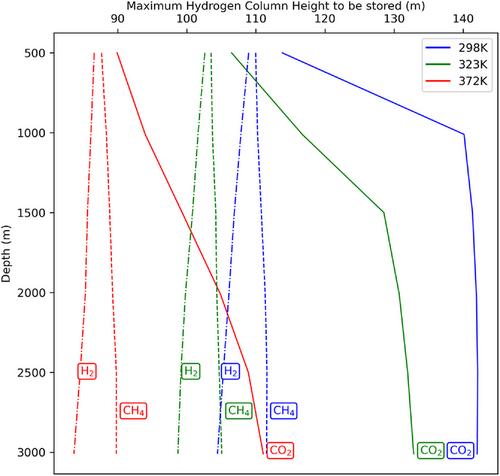下载PDF
{"title":"在 CO2${rm CO}_{2}$ 或其他气体储存的顶峰储存氢气的协同效应","authors":"Sabrine Ben Rhouma, Salaheddine Chabab, Daniel Broseta","doi":"10.1002/ghg.2278","DOIUrl":null,"url":null,"abstract":"<p>There are mutual benefits in storing <span></span><math>\n <semantics>\n <msub>\n <mi>H</mi>\n <mn>2</mn>\n </msub>\n <annotation>${\\rm H}_2$</annotation>\n </semantics></math> in sedimentary reservoirs jointly with another gas serving as a cushion gas, such as the <span></span><math>\n <semantics>\n <msub>\n <mi>CO</mi>\n <mn>2</mn>\n </msub>\n <annotation>${\\rm CO}_2$</annotation>\n </semantics></math> of a carbon capture and storage (CCS) operation or the natural gas of seasonal storage or left in a depleted hydrocarbon reservoir. When <span></span><math>\n <semantics>\n <msub>\n <mi>H</mi>\n <mn>2</mn>\n </msub>\n <annotation>${\\rm H}_2$</annotation>\n </semantics></math> occupies the crest of the reservoir, the presence of either gas is beneficial to the other. <span></span><math>\n <semantics>\n <msub>\n <mi>H</mi>\n <mn>2</mn>\n </msub>\n <annotation>${\\rm H}_2$</annotation>\n </semantics></math> reinforces the sealing efficiency of the caprock due to its very favorable interfacial properties with respect to brine and rock-forming minerals. <span></span><math>\n <semantics>\n <msub>\n <mi>H</mi>\n <mn>2</mn>\n </msub>\n <annotation>${\\rm H}_2$</annotation>\n </semantics></math> storage safety and capacity are also increased with cushion gases such as <span></span><math>\n <semantics>\n <msub>\n <mi>CO</mi>\n <mn>2</mn>\n </msub>\n <annotation>${\\rm CO}_2$</annotation>\n </semantics></math>, which alleviate the buoyancy pressure at the top of the gas column. The potential drawback of this storage scheme is gas/gas mixing, which can, however, be strongly reduced if, by an appropriate choice of well completion and placement, <span></span><math>\n <semantics>\n <msub>\n <mi>H</mi>\n <mn>2</mn>\n </msub>\n <annotation>${\\rm H}_2$</annotation>\n </semantics></math> is positioned in the upper zones of the reservoir, and its injection rate is kept below a critical value corresponding to the incipient fingering instability of the <span></span><math>\n <semantics>\n <mrow>\n <msub>\n <mi>H</mi>\n <mn>2</mn>\n </msub>\n <mrow>\n <mo>/</mo>\n <mi>cushion</mi>\n </mrow>\n </mrow>\n <annotation>${\\rm H}_2{/{\\rm cushion}}$</annotation>\n </semantics></math> gas mixing zone. This value, which depends on reservoir permeability, the dip angle of the mixing front, and how density varies with viscosity in the mixing front, turns out to be well above practical injection rates. Therefore, dispersive mixing is the only cause of front spreading, which is acceptable for not-too-heterogeneous reservoirs. The mutual benefits identified in this study are the strongest when the cushion is made up of dense <span></span><math>\n <semantics>\n <msub>\n <mi>CO</mi>\n <mn>2</mn>\n </msub>\n <annotation>${\\rm CO}_2$</annotation>\n </semantics></math>, which suggests that the crest of offshore <span></span><math>\n <semantics>\n <msub>\n <mi>CO</mi>\n <mn>2</mn>\n </msub>\n <annotation>${\\rm CO}_2$</annotation>\n </semantics></math> storage reservoirs is a good candidate for <span></span><math>\n <semantics>\n <msub>\n <mi>H</mi>\n <mn>2</mn>\n </msub>\n <annotation>${\\rm H}_2$</annotation>\n </semantics></math> storage. © 2024 The Authors. <i>Greenhouse Gases: Science and Technology</i> published by Society of Chemical Industry and John Wiley & Sons Ltd.</p>","PeriodicalId":12796,"journal":{"name":"Greenhouse Gases: Science and Technology","volume":"14 4","pages":"587-606"},"PeriodicalIF":2.7000,"publicationDate":"2024-05-20","publicationTypes":"Journal Article","fieldsOfStudy":null,"isOpenAccess":false,"openAccessPdf":"https://onlinelibrary.wiley.com/doi/epdf/10.1002/ghg.2278","citationCount":"0","resultStr":"{\"title\":\"Synergies of storing hydrogen at the crest of \\n \\n \\n CO\\n 2\\n \\n ${\\\\rm CO}_{2}$\\n or other gas storage\",\"authors\":\"Sabrine Ben Rhouma, Salaheddine Chabab, Daniel Broseta\",\"doi\":\"10.1002/ghg.2278\",\"DOIUrl\":null,\"url\":null,\"abstract\":\"<p>There are mutual benefits in storing <span></span><math>\\n <semantics>\\n <msub>\\n <mi>H</mi>\\n <mn>2</mn>\\n </msub>\\n <annotation>${\\\\rm H}_2$</annotation>\\n </semantics></math> in sedimentary reservoirs jointly with another gas serving as a cushion gas, such as the <span></span><math>\\n <semantics>\\n <msub>\\n <mi>CO</mi>\\n <mn>2</mn>\\n </msub>\\n <annotation>${\\\\rm CO}_2$</annotation>\\n </semantics></math> of a carbon capture and storage (CCS) operation or the natural gas of seasonal storage or left in a depleted hydrocarbon reservoir. When <span></span><math>\\n <semantics>\\n <msub>\\n <mi>H</mi>\\n <mn>2</mn>\\n </msub>\\n <annotation>${\\\\rm H}_2$</annotation>\\n </semantics></math> occupies the crest of the reservoir, the presence of either gas is beneficial to the other. <span></span><math>\\n <semantics>\\n <msub>\\n <mi>H</mi>\\n <mn>2</mn>\\n </msub>\\n <annotation>${\\\\rm H}_2$</annotation>\\n </semantics></math> reinforces the sealing efficiency of the caprock due to its very favorable interfacial properties with respect to brine and rock-forming minerals. <span></span><math>\\n <semantics>\\n <msub>\\n <mi>H</mi>\\n <mn>2</mn>\\n </msub>\\n <annotation>${\\\\rm H}_2$</annotation>\\n </semantics></math> storage safety and capacity are also increased with cushion gases such as <span></span><math>\\n <semantics>\\n <msub>\\n <mi>CO</mi>\\n <mn>2</mn>\\n </msub>\\n <annotation>${\\\\rm CO}_2$</annotation>\\n </semantics></math>, which alleviate the buoyancy pressure at the top of the gas column. The potential drawback of this storage scheme is gas/gas mixing, which can, however, be strongly reduced if, by an appropriate choice of well completion and placement, <span></span><math>\\n <semantics>\\n <msub>\\n <mi>H</mi>\\n <mn>2</mn>\\n </msub>\\n <annotation>${\\\\rm H}_2$</annotation>\\n </semantics></math> is positioned in the upper zones of the reservoir, and its injection rate is kept below a critical value corresponding to the incipient fingering instability of the <span></span><math>\\n <semantics>\\n <mrow>\\n <msub>\\n <mi>H</mi>\\n <mn>2</mn>\\n </msub>\\n <mrow>\\n <mo>/</mo>\\n <mi>cushion</mi>\\n </mrow>\\n </mrow>\\n <annotation>${\\\\rm H}_2{/{\\\\rm cushion}}$</annotation>\\n </semantics></math> gas mixing zone. This value, which depends on reservoir permeability, the dip angle of the mixing front, and how density varies with viscosity in the mixing front, turns out to be well above practical injection rates. Therefore, dispersive mixing is the only cause of front spreading, which is acceptable for not-too-heterogeneous reservoirs. The mutual benefits identified in this study are the strongest when the cushion is made up of dense <span></span><math>\\n <semantics>\\n <msub>\\n <mi>CO</mi>\\n <mn>2</mn>\\n </msub>\\n <annotation>${\\\\rm CO}_2$</annotation>\\n </semantics></math>, which suggests that the crest of offshore <span></span><math>\\n <semantics>\\n <msub>\\n <mi>CO</mi>\\n <mn>2</mn>\\n </msub>\\n <annotation>${\\\\rm CO}_2$</annotation>\\n </semantics></math> storage reservoirs is a good candidate for <span></span><math>\\n <semantics>\\n <msub>\\n <mi>H</mi>\\n <mn>2</mn>\\n </msub>\\n <annotation>${\\\\rm H}_2$</annotation>\\n </semantics></math> storage. © 2024 The Authors. <i>Greenhouse Gases: Science and Technology</i> published by Society of Chemical Industry and John Wiley & Sons Ltd.</p>\",\"PeriodicalId\":12796,\"journal\":{\"name\":\"Greenhouse Gases: Science and Technology\",\"volume\":\"14 4\",\"pages\":\"587-606\"},\"PeriodicalIF\":2.7000,\"publicationDate\":\"2024-05-20\",\"publicationTypes\":\"Journal Article\",\"fieldsOfStudy\":null,\"isOpenAccess\":false,\"openAccessPdf\":\"https://onlinelibrary.wiley.com/doi/epdf/10.1002/ghg.2278\",\"citationCount\":\"0\",\"resultStr\":null,\"platform\":\"Semanticscholar\",\"paperid\":null,\"PeriodicalName\":\"Greenhouse Gases: Science and Technology\",\"FirstCategoryId\":\"93\",\"ListUrlMain\":\"https://onlinelibrary.wiley.com/doi/10.1002/ghg.2278\",\"RegionNum\":4,\"RegionCategory\":\"环境科学与生态学\",\"ArticlePicture\":[],\"TitleCN\":null,\"AbstractTextCN\":null,\"PMCID\":null,\"EPubDate\":\"\",\"PubModel\":\"\",\"JCR\":\"Q3\",\"JCRName\":\"ENERGY & FUELS\",\"Score\":null,\"Total\":0}","platform":"Semanticscholar","paperid":null,"PeriodicalName":"Greenhouse Gases: Science and Technology","FirstCategoryId":"93","ListUrlMain":"https://onlinelibrary.wiley.com/doi/10.1002/ghg.2278","RegionNum":4,"RegionCategory":"环境科学与生态学","ArticlePicture":[],"TitleCN":null,"AbstractTextCN":null,"PMCID":null,"EPubDate":"","PubModel":"","JCR":"Q3","JCRName":"ENERGY & FUELS","Score":null,"Total":0}
引用次数: 0
引用
批量引用



